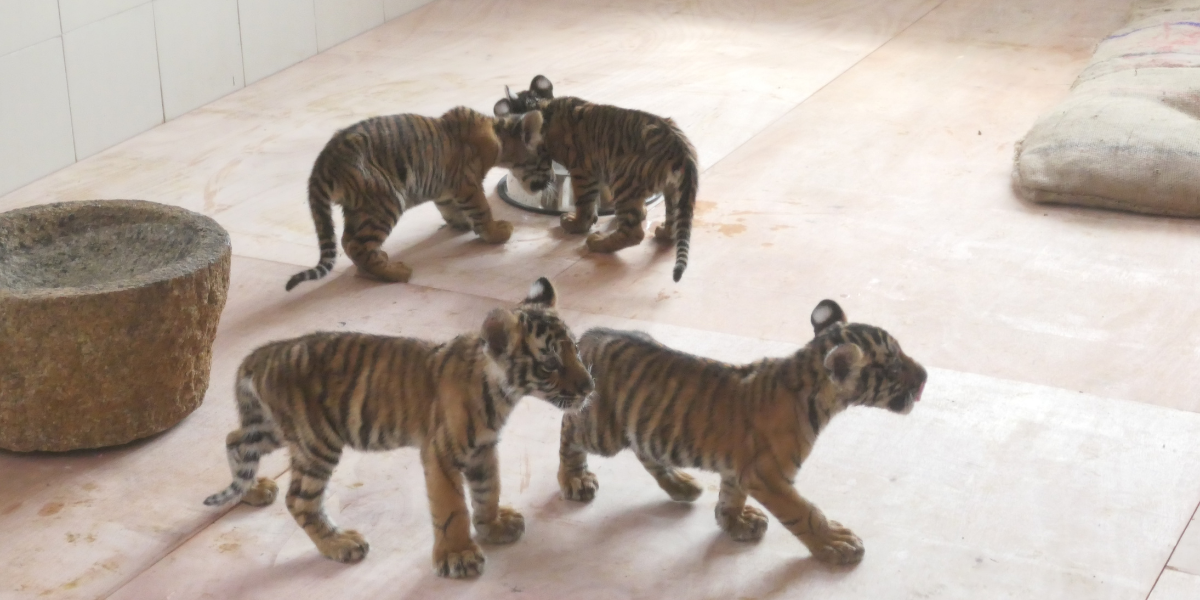As per NTCA protocol, the four tiger cubs will be released into an animal rescue centre attached to the zoo as part of the rewilding process.

The Andhra Pradesh Forest Department officials have shifted the cubs to SV Zoological Park in Tirupati. (Supplied)
After two futile attempts to reunite four abandoned tiger cubs — rescued by locals in the Atmakur forest range — with their mother, the Andhra Pradesh Forest Department officials shifted them to Sri Venkateswara (SV) Zoological Park in Tirupati on Friday, 10 March.
Aged around three months, the four tiger cubs will be released into the animal rescue centre that is attached to the zoo as a part of the rewilding process, as per the National Tiger Conservation Authority (NTCA) guidelines.
The cubs were sighted by the villagers of Pedda Gummadapuram in Kothapalli Mandal in Nandyal district on 6 March, following which the forest officials were informed.
On the same night, the forest officials made a first attempt to reunite the cubs with their mother by leaving them in the forest. However, with no trace of their mother in the vicinity, they dropped the plan and brought them back to the guest house.
Late on Wednesday night, the forest officials took the cubs to the spot where a shepherd had reported sighting a big cat. They waited till early Thursday but the mother did not turn up. A second failed attempt.
“As per the advice of the NTCA, we have decided to shift the cubs to SV Zoo in Tirupati. The cubs have already reached Tirupati and, currently, they are at the veterinary care centre there,” deputy director of the Nagarjuna Sagar Srisailam Tiger Reserve (NSTR) and Atmakur Divisional Forest Officer (DFO) Alan Chong Teron told South First.
He continued, “They will soon be released into the animal rescue centre for an in situ enclosure setup attached to the zoo as part of the rewilding process. Later on, they will be released into the forest as per the NTCA protocol for such abandoned tiger cubs.”
Since Monday morning, the forest officials have been engaged in extensive efforts to trace the tigress to reunite her with her cubs.
Following the second failed attempt on Thursday morning, the cubs were brought back to the forest guest house at Nallamala Jungle Camp Bairluty where they remained under the care of a team of veterinarians.
The forest officials had found pugmarks of a tigress on Wednesday morning about 1.5 km from the site where the cubs were found by the villagers. A shepherd had also reported a direct sighting of a big cat near the village on Wednesday evening. This had raised hopes of reuniting the cubs with their mother.
“All the four cubs are healthy, active, and normal,” added Alan Chong. At least 70 trap cameras and flashless infrared sensors/detectors have been set up in a 200-metre radius from where the cubs were found.
The cubs are now feasting on mashed chicken liver, Royal Canin, and milk, besides oral rehydration solution (ORS) and fluid-state multivitamins.
SV Zoo assistant conservator K Nagabhushanam said that medical check-ups are being conducted on the cubs and they will be monitored via CCTV cameras around-the-clock.
As per the NTCA-prescribed SOPs, the re-wilding process — the imparting of the skills the cubs would need to survive there — should be carried out for at least two years before they are released into the wild, stated Alan Chong.
“Under no circumstances should tiger cubs of the opposite sex be reared together. The tiger cubs should be reared in the in-situ enclosure for a minimum of two years and each cub should have a successful kill record of at least 50 prey animals, since the re-wilding process requires time,” said another senior forest official.
The tiger cubs that have a successful kill record may be released in the wild — in consultation with the NTCA and after radio-collaring — to a suitable, productive habitat within the same landscape, while considering the land tenure dynamics of tigers and the presence of human settlements in the new area.

Apr 19, 2024

Apr 19, 2024

Apr 19, 2024

Apr 18, 2024

Apr 18, 2024